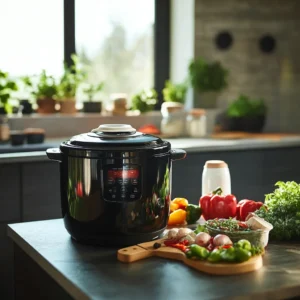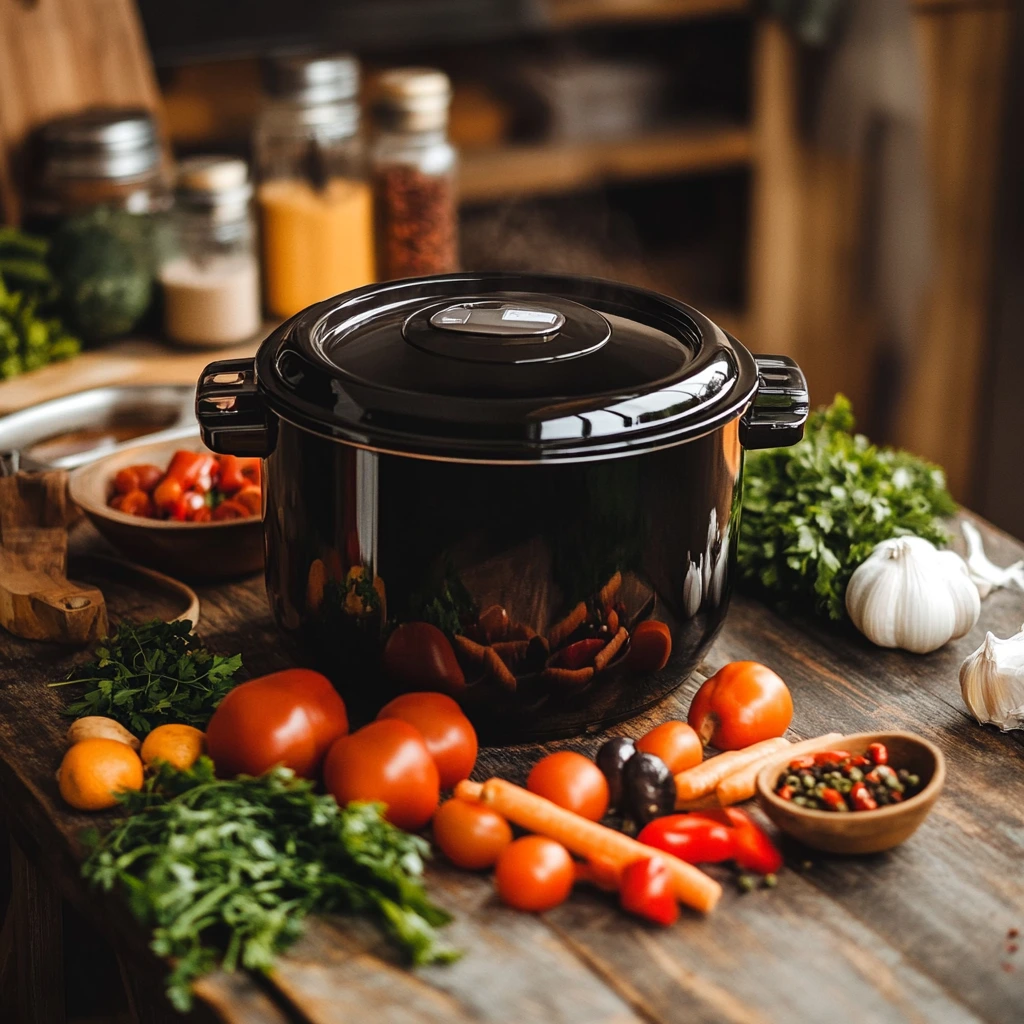Welcome to our in-depth guide on healthy crockpot recipes. In today’s fast-paced world, the slow cooker has become a staple for those seeking to enjoy nutritious meals without spending hours in the kitchen.
This article explores the benefits of crockpot cooking, details essential ingredients, provides practical tips and tricks, and presents a variety of recipe categories that are sure to inspire your next meal. Whether you’re a seasoned home chef or a beginner exploring healthier cooking methods, this guide is designed to offer insights that blend convenience with exceptional flavor and nutrition.
For additional insights on the science behind slow cooking, check out our article on the difference between slow cooker and crockpot. You can also explore expert tips on managing your nutritional goals with guidance from healthy eating tips.
Introduction
The allure of healthy crockpot recipes lies in their remarkable ability to merge convenience with robust nutritional value. A slow cooker not only retains the natural flavors and essential vitamins of your ingredients but also provides a hands-off cooking experience that lets you focus on other tasks. This guide will delve into several key areas:
- Benefits of Crockpot Cooking: Discover how slow cooking enhances flavors while preserving vital nutrients.
- Essential Ingredients: Learn which lean proteins, fresh vegetables, whole grains, and healthy fats can elevate your meals.
- Practical Tips & Tricks: Gain insights into layering ingredients, balancing macronutrients, and managing portion sizes.
- Diverse Recipe Categories: Explore a variety of recipes including soups, lean meat dishes, vegetarian options, and gluten-free meals.
- Step-by-Step Guidance: Follow a detailed process to create your own healthy crockpot recipes.
- Frequently Asked Questions: Get answers to common questions that will help you overcome challenges and fine-tune your cooking techniques.
By integrating these elements, you’ll not only master the art of slow cooking but also discover how to make each meal a celebration of both flavor and health.
The Benefits of Using a Crockpot for Healthy Cooking
The crockpot is a powerhouse when it comes to creating nutritious meals. Here are some of the key benefits of using a slow cooker in your healthy eating regimen:
-
Enhanced Flavor & Nutrient Retention:
Slow cooking at low temperatures allows the ingredients to release and blend their natural flavors gradually. This method helps preserve delicate vitamins and minerals that are often lost during high-heat cooking. The result is a dish that bursts with flavor while retaining its essential nutritional profile. -
Convenience & Time Management:
One of the greatest advantages of using a slow cooker is the convenience it offers. Prepare your ingredients in the morning, set the timer, and by dinner time, you have a ready-to-eat meal. This approach not only minimizes the time you spend actively cooking but also makes it easier to plan meals ahead of time. -
Cost-Effectiveness & Versatility:
Using a crockpot allows you to cook larger batches of food at once, which is ideal for budgeting and reducing food waste. You can transform inexpensive cuts of meat into tender, flavorful dishes by cooking them slowly. Moreover, the versatility of the slow cooker means you can experiment with various recipes—from hearty stews to light, vegetable-based meals. -
Improved Digestion & Health Benefits:
The long, slow cooking process breaks down fibers and makes nutrients more accessible, which can be particularly beneficial for those with digestive issues. By choosing lean proteins and fresh vegetables, you create meals that support a balanced diet, promote sustained energy levels, and contribute to overall wellness.
Understanding Your Crockpot: How It Works
Before you dive into creating your own healthy crockpot recipes, it’s essential to understand the mechanics behind your slow cooker. Here’s a closer look:
-
The Slow Cooking Process:
A crockpot operates by cooking food at a consistently low temperature over several hours. This gradual process allows tougher cuts of meat to become tender and ensures that the flavors of the ingredients meld together harmoniously. The low, steady heat minimizes the risk of overcooking, making it easier to achieve perfectly cooked meals every time. -
Modern Features & Settings:
Today’s slow cookers come equipped with a variety of features designed to simplify cooking. Programmable settings, digital timers, and adjustable heat controls give you greater precision and flexibility. Whether you prefer a “warm” setting or a specific cooking duration, these features enable you to tailor the cooking process to your exact needs. -
Health-Focused Modifications:
The beauty of using a crockpot lies in its adaptability. By choosing lean proteins, fresh vegetables, and whole grains, you can modify traditional recipes to enhance their nutritional value. For more detailed insights on healthy ingredient substitutions, consider reading our guide on instant pot recipes for weight loss.
Essential Ingredients for Healthy Crockpot Meals

A delicious and nutritious crockpot meal starts with the right ingredients. Here are some fundamental components to consider:
-
Lean Proteins: Incorporate proteins that are low in fat but high in quality. Options include:
- Chicken, turkey, lean beef, tofu, and legumes
These proteins not only support muscle growth but also provide lasting energy.
- Chicken, turkey, lean beef, tofu, and legumes
-
Fresh Vegetables & Fruits: Vegetables are the cornerstone of a healthy diet. Opt for:
- Seasonal and organic produce such as carrots, spinach, bell peppers, tomatoes, and more
They add color, flavor, and essential vitamins to your dishes.
- Seasonal and organic produce such as carrots, spinach, bell peppers, tomatoes, and more
-
Whole Grains & Legumes: To create balanced meals, include:
- Brown rice, quinoa, beans, and other whole grains
These ingredients offer complex carbohydrates and fiber, which are important for sustained energy and digestive health.
- Brown rice, quinoa, beans, and other whole grains
-
Healthy Fats & Seasonings: A little goes a long way in flavoring your meals. Use:
- Olive oil, herbs, and spices
These add depth to your dishes without unnecessary calories.
- Olive oil, herbs, and spices
For creative ideas on plant-based ingredients and how to incorporate them effectively, you might enjoy our ultimate guide to eggplant recipes.
Tips and Tricks for Creating Nutritious Crockpot Recipes
Making the most of your crockpot involves not just selecting the right ingredients, but also understanding how to combine and cook them. Here are some practical tips:
-
Balance Your Macronutrients:
Ensure each meal includes the right mix of proteins, carbohydrates, and fats. This balance is key for sustained energy and overall wellness. Use a variety of ingredients to meet your daily nutritional needs. -
Layer Ingredients Strategically:
One of the secrets to a successful crockpot meal is layering. Start with ingredients that require a longer cooking time (such as root vegetables and tougher cuts of meat), and add more delicate items (like leafy greens) later in the cooking process to maintain their texture and flavor. -
Portion Control:
Cooking in a crockpot allows you to prepare meals in bulk, which can then be portioned out for balanced, calorie-conscious servings. Consider investing in good storage containers so you can enjoy your healthy creations throughout the week. -
Adapt Traditional Recipes:
Many traditional crockpot recipes can be modified to become healthier. Substitute high-sodium broths with low-sodium options, replace heavy cream with plant-based alternatives, and experiment with herbs and spices to reduce the need for extra salt. -
Experiment with Flavor Enhancers:
Don’t be afraid to add a little twist to your recipes. A splash of lemon juice, a sprinkle of fresh herbs, or a dash of your favorite spice blend can elevate the dish without compromising its nutritional value.
For more innovative recipes that push the boundaries of traditional slow cooking, explore our delicious stuffed zucchini recipes.
Detailed Recipe Categories and Their Health Benefits
Our collection of healthy crockpot recipes spans several categories, each offering unique benefits tailored to your dietary needs.
Soups & Stews
Soups and stews are classic examples of meals that thrive in a slow cooker. They are perfect for harnessing the benefits of slow cooking:
- Key Ingredients:
- Lean proteins such as chicken or turkey
- A rich assortment of vegetables and legumes
- Herbs and spices to intensify flavor
- Health Benefits:
- High in vitamins, minerals, and fiber
- Excellent for hydration and gentle on the digestive system
- Ideal for cold weather or anytime you need a comforting, hearty meal
Lean Meat & Poultry Recipes

Recipes featuring lean meats are a staple of healthy crockpot recipes. These dishes provide the protein needed for muscle maintenance while keeping the fat content in check:
- Examples:
- Crockpot chicken stew with vibrant vegetables
- Turkey chili enriched with beans and spices
- Low-fat beef recipes that transform tougher cuts into tender, flavorful dishes
- Health Benefits:
- Rich in high-quality protein essential for body repair and energy
- Lower in saturated fats, making them heart-healthy options
- Versatile enough to be served with a side of whole grains or vegetables
Vegetarian & Vegan Options
For those who follow a plant-based diet, slow cooking offers an excellent way to extract maximum flavor from vegetables and legumes:
- Examples:
- Hearty legume-based chili with a mix of beans and vegetables
- Vegetable curries that infuse tofu with aromatic spices
- Stews that combine a variety of plant-based proteins and fresh produce
- Health Benefits:
- High in fiber and antioxidants
- Rich in vitamins and minerals essential for overall health
- Supports cardiovascular wellness and helps maintain steady energy levels
Gluten-Free & Low-Carb Recipes
Adapting healthy crockpot recipes to meet gluten-free and low-carb requirements is easier than ever:
- Examples:
- Vegetable soups prepared with quinoa or other gluten-free grains
- Lean protein dishes paired with low-carb vegetables
- Stews designed to stabilize blood sugar while delivering robust flavors
- Health Benefits:
- Suitable for individuals with gluten sensitivities or celiac disease
- Helps maintain balanced blood sugar levels
- Ideal for weight management and sustained energy throughout the day
For more healthy meal inspirations that cater to a variety of dietary needs, be sure to check out our post on easy weeknight crockpot meals.
Step-by-Step Guide to Creating a Healthy Crockpot Recipes

Follow these detailed steps to create your own healthy crockpot recipes:
- Plan Your healthy crockpot recipes:
- Choose Your Ingredients:
Begin with a well-thought-out list of ingredients. Prioritize lean proteins, an assortment of fresh vegetables, and whole grains or legumes. Consider seasonal produce for the best flavor and nutritional value. - Measure Proportions:
Carefully measure your ingredients to ensure a balanced mix. This helps in maintaining the nutritional integrity and achieving a harmonious blend of flavors.
- Choose Your Ingredients:
- Prepare & Layer Ingredients:
- Layering Strategy:
Place the ingredients that require the longest cooking time at the bottom of the crockpot. Root vegetables and tougher cuts of meat should go first.
Next, add items that cook relatively quickly, such as mushrooms and bell peppers. Finally, incorporate delicate greens or herbs toward the end of the cooking process. - Pre-Preparation Tips:
Chop vegetables uniformly for even cooking, and consider lightly sautéing aromatics like garlic and onions to intensify their flavor before adding them to the pot.
- Layering Strategy:
- Set the Cooking Process:
- Temperature & Timing:
Use your crockpot’s programmable settings to maintain a low, steady temperature. Depending on your recipes, set the cooking time anywhere from 4 to 10 hours.
Slow cooking not only tenderizes the food but also allows flavors to deepen and meld together beautifully. - Monitor Occasionally:
Although crockpot cooking is designed to be hands-off, an occasional check can help ensure that everything is progressing as planned. Adjust the heat or add a splash of liquid if necessary.
- Temperature & Timing:
- Finish with Flavor Enhancers:
- Garnishes & Seasonings:
Just before serving, add fresh herbs like basil, cilantro, or parsley. A squeeze of lemon or a dash of your favorite spice blend can brighten up the dish and add an extra layer of flavor. - Taste & Adjust:
Give your meal a final taste test and adjust salt, pepper, or acidity as needed to suit your palate.
- Garnishes & Seasonings:
For further details on managing your kitchen tools effectively, you may also appreciate our how to sharpen a knife guide.
Frequently Asked Questions (FAQs)
Below are detailed answers to some common queries about healthy crockpot recipes:
What are the best lean proteins for crockpot recipes?
- Chicken, turkey, and tofu are excellent choices for high-quality protein with minimal fat content. They absorb flavors well and become wonderfully tender when slow-cooked.
Can I use fresh vegetables in a crockpot?
- Fresh vegetables work perfectly, but it’s important to add delicate items later in the cooking process to maintain their nutritional value and texture. Root vegetables can go in at the beginning, while greens and herbs should be added closer to serving time.
How do I avoid mushy vegetables?
- Layer Strategically: Start with sturdy vegetables that require longer cooking times, and add more delicate ones later in the process.
- Monitor Cooking Time: Adjust the cooking time based on the type of vegetables you are using to ensure they remain firm yet tender.
Are crockpot meals suitable for weight loss?
- When crafted with lean proteins, fresh vegetables, and whole grains, crockpot recipes can be a vital part of a balanced weight loss strategy. The focus on nutritious ingredients and portion control helps in managing calorie intake effectively.
What makes healthy crockpot meals better than conventional cooking methods?
- Slow cooking enhances the natural flavors of ingredients while preserving essential nutrients. This method reduces the need for extra fats and salts, making it a more nutritious option for everyday meals.
For more healthy eating tips and weight management strategies, consider reading about instant pot recipes for weight loss.
Conclusion
Healthy crockpot recipes offer an exceptional way to enjoy delicious, balanced meals with minimal effort. The slow cooker not only preserves essential nutrients and natural flavors but also gives you the freedom to experiment with a wide range of ingredients and cooking techniques. By embracing the simplicity of slow cooking, you can transform everyday ingredients into gourmet, nutritious dishes.
- Experiment: Try different ingredient combinations and adjust recipes to suit your taste and nutritional needs.
- Plan Ahead: Utilize your crockpot for batch cooking to streamline your weekly meal preparation, ensuring you always have a healthy option on hand.
- Enjoy Simplicity: Remember that slow cooking is about making the most of natural flavors with minimal fuss.
For a deeper dive into the benefits of various ingredients, explore our comprehensive guides on related topics such as what is a pressure cooker best for.


2 thoughts on “Healthy Crockpot Recipes: A Comprehensive Guide to Nutritious Slow-Cooked Meals”